Blog •
Last updated on Nov 18, 2021
7 Tips for Creating a Reedsy Freelancer Profile
The Reedsy marketplace is home to the world’s best freelance publishing talent, from editors and ghostwriters, to book cover designers and marketers. And with over 1 million authors looking for professionals to help them with their manuscripts, there’s plenty of work to go around. But as a freelancer, how do you attract the projects that resonate with you and excite you among all the gigs available? The answer: with a top-notch freelancer profile.
Your freelancer profile is what allows you to match with relevant authors. To make sure your profile contains all the necessary ingredients to convince them you’re the person for the job, and they are the right client for you, here are 7 tips from the Reedsy team, based on what we’ve seen works on the marketplace — along with some freelancer profiles to get inspired by.

JOIN OUR NETWORK
Supercharge your freelance career
Find projects, set your own rates, and get free resources for growing your business.
1. Add a professional and friendly profile image
The profile photo is one of the first things authors come across when they’re searching for freelancers on the marketplace. And, as they say, first impressions matter.
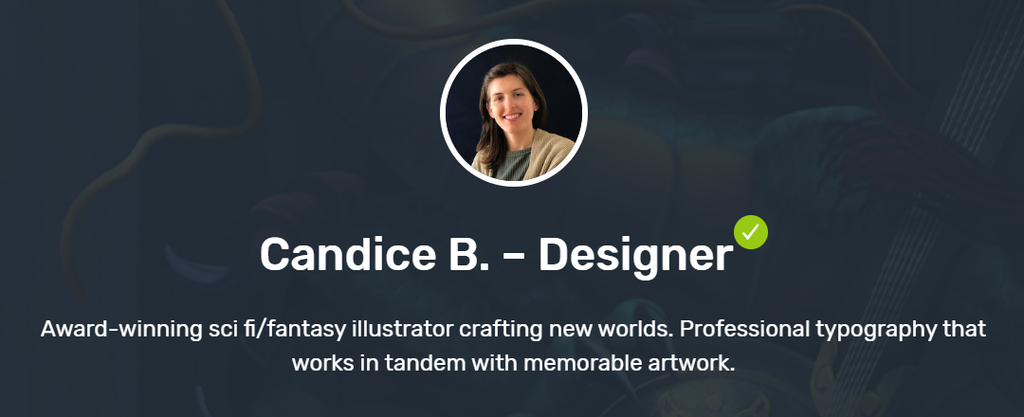

A friendly, clear, and professional profile photo can make a world of difference. Both Margaret M. and Candice B. nail it with these shots.
In a remote work environment, it’s key to build connection, starting with a welcoming profile picture — one where you look friendly and approachable, yet professional and qualified to help future clients with their writing project. We’ve found that those with smiling, clear, and professional photos of themselves where the face is centered receive more requests than those that feature pets, landscapes, or heavy filters, while those with lower quality photos or no photo at all consistently underperform.
💡Top tip: If you don’t have a professional headshot, don’t worry: you can use free online tools (like Profile Pic Maker) to create a clean profile pic in seconds 一 starting from a selfie or other personal photos.
2. Be specific in your short description
The second thing that authors see when they’re browsing profiles on the marketplace is the ‘Short description’ — the 140 characters that appear below your profile photo on your main profile page and below your name in the profile previe

Front load all the essential information about yourself in the short description, which shows up in the preview too, to increase the chances of authors checking your full profile out.
Treat your short description like an elevator pitch by immediately conveying essential information about the services you offer, the genres you work with, and a hook.
Margaret’s short description above is a textbook example, narrowing down her field of expertise, while including her credentials as a hook to capture the attention of authors. You can also choose to add a bit of personality or mention something about your personality and working style, major publishers or authors you’ve worked with, or if you’ve worked on a New York Times bestseller, for instance.
Authors want a specialist
We don’t recommend appealing to the masses with broad statements in your short description (or in the rest of your profile). Since authors spend a considerable amount of time and money on turning their publishing dreams into reality, they’re looking for someone who fits their project specifically.
Freelancers are much more successful the more specific they are since this conveys passion and expertise. For instance, saying “I’m an editor specializing in fiction writing,” sounds vague and noncommittal. To impress upon the reader that you’re passionate and particularly suited to their project, narrow down what type of service you excel at (e.g. developmental editing) and what sub-genres you’re particularly interested and knowledgeable in (e.g. YA and Middle Grade).
Exuding confidence and pinpointing the types of projects you’re seeking will give you the edge over a generalist who does a bit of everything, helping you attract more relevant clients. After reading your short description, if an author takes an interest in your work, they’ll click on your name and be taken to your profile. The next thing they see will be your ‘Overview’ section.
3. Make your overview relevant to authors
The purpose of the ‘Overview’ section is to expand on your professional experience, what you specialize in, how you work, and why an author should work with you. It should include enough detail to paint a clear picture of who you are, but not so much as to overwhelm or make it feel like a chore to read. Keeping it on the shorter end is preferable, as this allows authors to scroll down to your experience section and, most importantly, portfolio and gallery more quickly.
💡Remember to write in first person to build your connection with the reader.

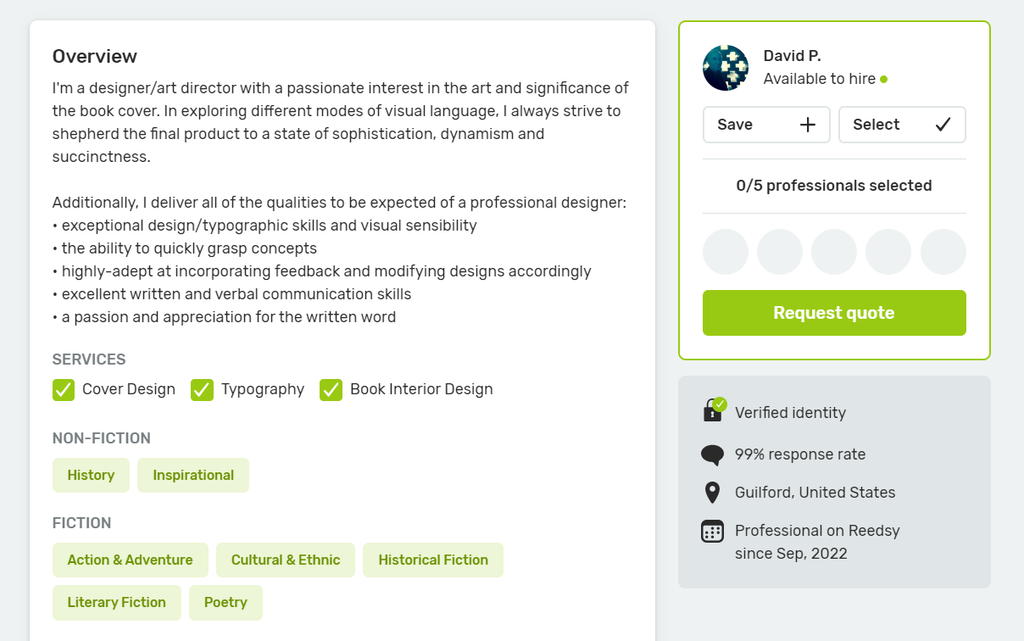
💡Top tip: Consider adding one or two testimonials from previous clients outside of Reedsy in the overview section if you’re new to the marketplace, but keep them brief. When you receive a couple of reviews from Reedsy clients, these will automatically show up at the bottom of your profile so you can remove the external testimonials to keep your overview concise.
Anticipate clients’ concerns
Beyond the basic introduction, anticipating some of the questions or concerns that authors might have about the process and answering them directly in the overview is a great way to convey expertise.

⚠️Note: We’re all for finding inspiration from other freelancers, but avoid copying and pasting other professionals’ profiles at all cost! If our vetting team suspects plagiarism or detects too much similarity with existing profiles, we will likely deactivate or not accept your profile.
4. Record an introductory video
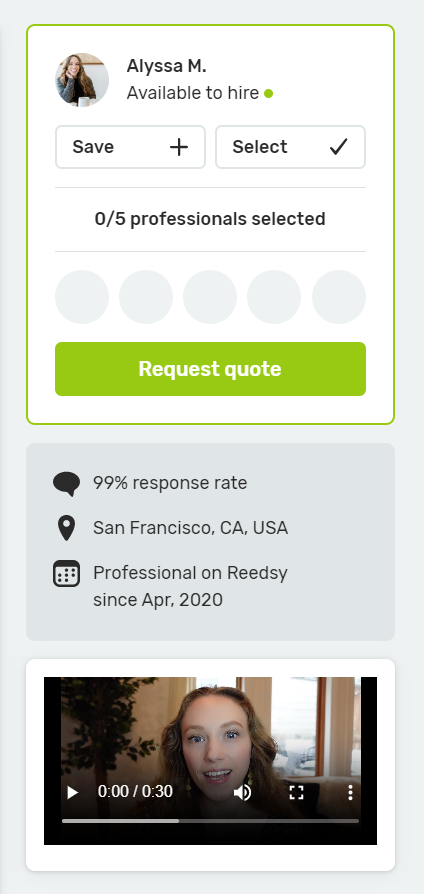
Authors are always looking for collaborators they will click with, so displaying
a bit of personality in your short description and overview is highly recommended. And if you want to go the extra mile, show the face behind the work by including a short video!
It doesn’t have to be anything extravagant: editor Alyssa M. manages to say hi, introduce her services, and drop a few fun facts (including her adorable pet) in just 30 seconds — that’s all it takes. You don’t want to repeat the things you’ve already stated in writing, but rather focus on showing who you are as a person.
📽️ Find our guide to adding a video to your profile here.
A lot of authors are worried about having their work read by a professional — especially a stranger they hired online, so showing that you’re a real and friendly person who will see them and their work is an important part of creating a trusting and successful working relationship.
💡Top tip: If you’re camera shy, remember that you’ve already outlined your credentials and experience in the rest of your overview and the main purpose of the video is simply to show that there’s a real person on the other end. Being nervous is natural and may even make you seem more approachable!
5. Narrow down your services and genres
To be discovered by the right authors, freelancers can add helpful tags to their profile below their ‘Overview’ section. These tags correspond to the filters that authors use to browse the marketplace (type of service, language, and genre) and how you fill them in will affect which searches you appear in.
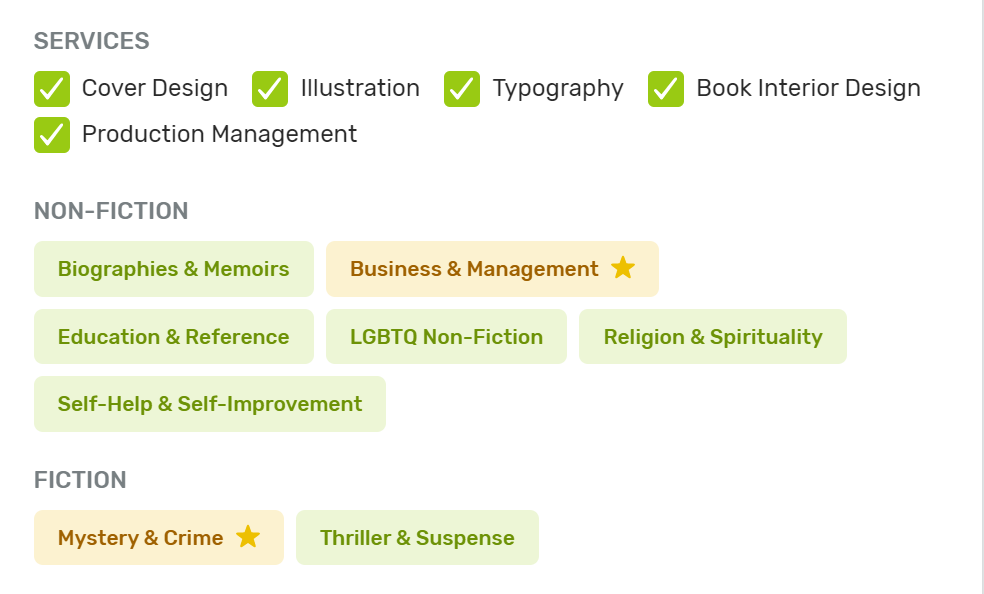
For genres, you can pick up to 8 discrete ones, but, again, we highly encourage you to be selective: it’s better to pick just a few that you truly specialize in than to try and catch ‘em all. Among your selection, you can also 'star' a few to show that those are the types of projects you're particularly looking for.
Another reason to be selective is to expand your reach. Contrary to what many believe, picking sub-genres instead of general ones makes you much more discoverable. That’s because if you choose ‘Picture Books’ instead of the parent genre ‘Children’s,’ you’ll appear in searches for both, whereas if you pick ‘Children’s,’ you won’t appear in searches for ‘Picture Books’ at all. However, it goes without saying that the tags should be relevant and consistent with the rest of your profile.
6. Put your experience on display
The ‘Work Experience’ part of the profile is your chance to present your publishing bona fides. Knowing your previous employment and the trust other publishers and authors have put in you reassures future clients about your skills and qualifications. Moreover, your years of experience with traditional publishers is an important criterion that the Reedsy team looks at during the selection process.
Ideally, for each experience, you want to give one or two sentences explaining what you did or achieved while you were there. If you can hone in on experiences in your specialties (especially in terms of your preferred genres), that’s ideal, since it creates a red thread throughout your profile.
💡Top tip: Remember that your profile is being read by authors, and not recruiters. Our data rather shows that authors are much more likely to contact you if you can give concrete examples of titles and authors you’ve worked on that they’re familiar with, and specific achievements, rather than your responsibilities in past employment. And, most importantly, don’t forget to highlight what you’ve achieved as a freelancer, since this is perhaps most relevant of all.
7. Curate your portfolio
One of the most important parts of your Reedsy profile is your portfolio. That is, the collection of titles you’ve worked on in the past. That’s because the portfolio provides a visual and concrete confirmation of your experience.
Ideally, the titles you pick for your portfolio should match and complement the rest of your profile and genre tags to indicate the kinds of projects you have previously worked on and want to work on in the future.
☝️Note: the Reedsy vetting team also uses the portfolio to check whether freelancers fit our selection criteria or not.
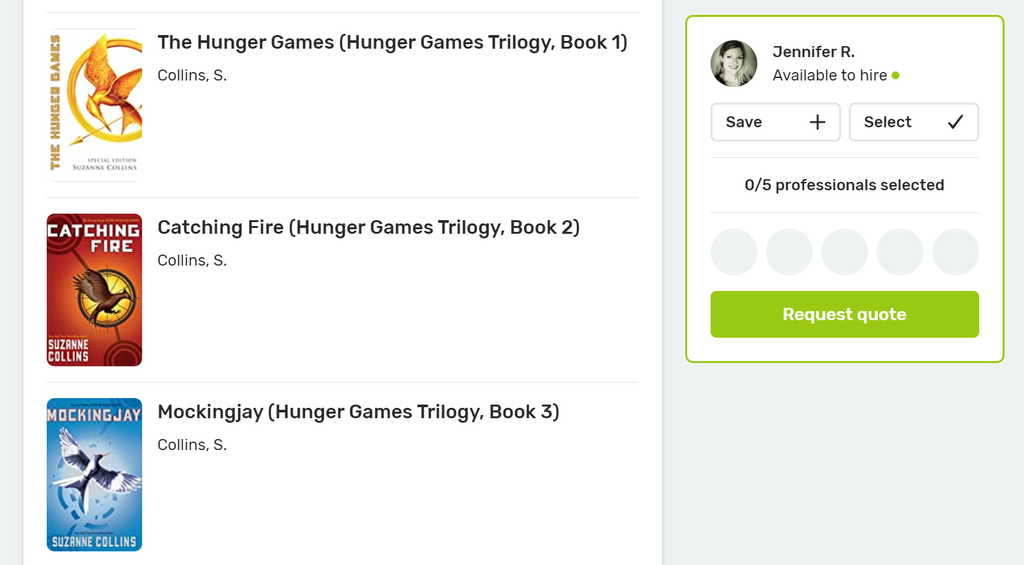
It’s also important to be selective and to frequently update your portfolio as this shows that you’re purposeful and considerate in everything you do. You’re not simply adding every title you’ve ever worked on, hoping one of them will tip the scale in your favor. Instead, you’re confident that you have more than enough quality material to go around, and you’ve selected a handful of recent and relevant examples to showcase your abilities. As a rule of thumb, two to three books for each genre you mention should cover your bases.
💡Top tip: Avoid adding several titles by the same author. This makes your portfolio unnecessarily saturated and may look clumsy and unprofessional. Instead, use the space to showcase your versatility, while still curating it to indicate your area of expertise.
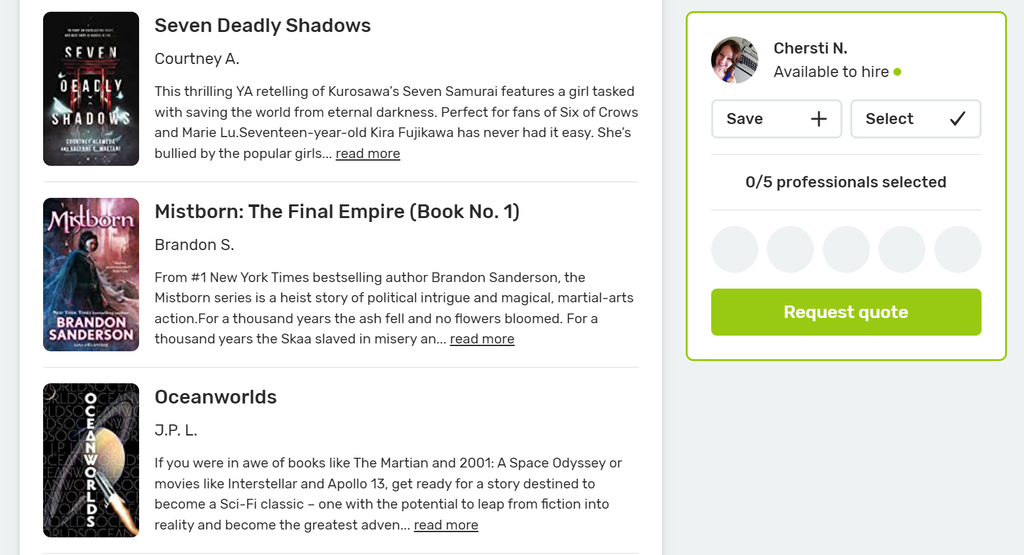
💡Top tip: Update your portfolio frequently to make sure your most impressive or recent work is at the top. The three first books in your portfolio will show up in your profile preview in marketplace searches.
And if there’s a kind of book you have worked on, but you don’t necessarily want to work on again, there’s no need to include it in your portfolio. You can afford to be a bit picky and decide what type of projects you’d like to attract.
💡Top tip: You can also tag what services you have performed for each book, as well as mention whether it was made here on Reedsy.
 As for the actual steps of adding books to your portfolio, it’s pretty straightforward. Simply paste the Google Play, Apple Books, or Amazon link of the book into the box on your ‘Edit Profile’ page.
As for the actual steps of adding books to your portfolio, it’s pretty straightforward. Simply paste the Google Play, Apple Books, or Amazon link of the book into the box on your ‘Edit Profile’ page.
Designers and illustrators can display work in the ‘Gallery’
Other than adding books to their portfolios, cover designers and book illustrators also have the option to upload samples of their work to the ‘Gallery’ section. This is an opportunity to show off your range of styles and skills across your chosen genres in more detail.
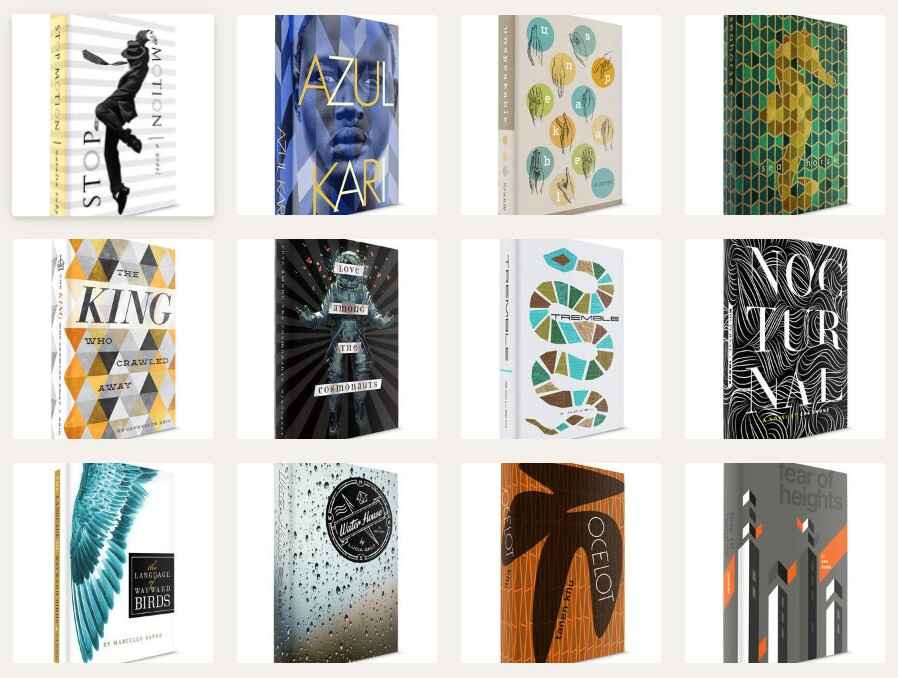
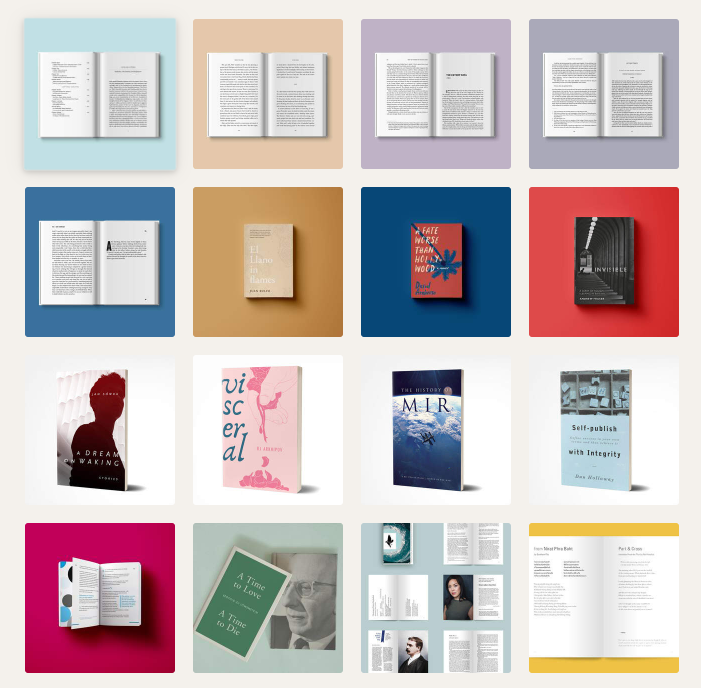
💡Top tip: When you add images to your gallery, you can rearrange them as you wish. If you want to adjust your portfolio there is a 'pin' button that lets you send items to the top of the list.
Marketers, publicist, and web designers can use the ‘Projects’ section
Marketers, publicists, and web designers have a ‘projects’ section to their disposal. Of all the kinds of publishing professions out there, marketing and branding is possibly one of the most collaborative ones, since the author has to be actively involved in building their own public image. As such, potential clients tend to care not only about the outcome of marketing or web designing products; they’ll also want to know about your problem-solving process.
To demonstrate this, you can use the ‘Projects’ section in your profile. Here you can explain the brief, demonstrate what you did during the project, and then reveal the amazing results that you’ll be able to replicate for future clients. You can also add photos to each project to visually show your progress and results.

Now that your Reedsy profile is all set up, check these 7 insider tips on how to boost your profile even further. And if you have any questions about creating a Reedsy professional profile or joining the Reedsy marketplace as a freelancer, hit the ‘HELP’ button to drop us a message.
Finally, for even more insights and examples, check out this webinar where Reedsy's Head of Operations breaks down how to optimize your profile for visibility on the marketplace.
If you're already confident in your profile, take a look at our offer letter checklist to make sure you're doing everything you can to land the job(s):

FREE RESOURCE
Offer Letter Checklist + Template
Follow our tips to successfully sell clients on your services while setting clear expectations.
